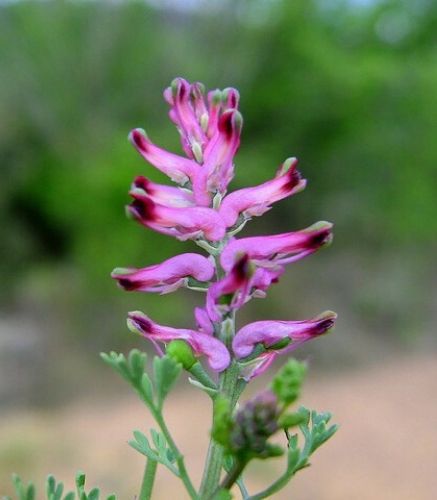Actifs Naturels : Fumeterre
Fumeterre

-
Alcaloïdes (de type Benzylisochinoline) (1,25%) :fumarine (=protopine), protoberbérine, fumaricine, fumariline, entre autres
La fumarine est un colorant jaune. Elle constitue l'action principale de a plante, mais la combinaison avec des alcaloïdes secondaires dans l'extrait total est importante.
-
Flavonoïdes : rutine, quercétine-glycosides, entre autres
-
Acides carboniques : acide chlorogénique, acide fumarique et acide caféique.
Herba (Herbe)
La fumeterre possède des propriétés antibactériennes et antispasmodiques.
Cela est en partie dû à l’alcaloïde fumarine qui est un spasmolytique, avec une activité antihistaminique et légèrement sédative.
Les propriétés antihistaminiques et sédatives de la fumarine ont été étudiées par Abdul Habib et al. , 1973.
L’activité bactéricide contre les organismes Gram + tels que Bacillus anthracis et Staphylococcus a été rapportée par l’étude de Preininger et al. en 1975.
En outre, la fumarine se révèle également un antitussif et un bronchodilatateur.
En cas de bronchite allergique et d’asthme allergique également, la fumeterre prouve son efficacité. La fumeterre calme efficacement la toux, non seulement lorsque l’envie de tousser est d'origine allergique, mais aussi en cas d'infection des voies respiratoires (refroidissements, états grippaux, bronchites, etc.).
Son action atténue l'envie de tousser en agissant sur les picotements qui induisent le réflexe de toux.
L’action rapide de la fumeterre contre la toux s'explique par le fait que cette herbe agit non seulement de façon locale (sur la trachée, par exemple), mais aussi de façon centrale, en agissant sur le centre de la toux.
Aucune réaction anormale si l’on respecte la posologie recommandée.
1. Hänsel. HAGERS HANDBUCH : Drogen. Springer Verlag, Berlin (1992).
2. Paul Walsch. PDR for Herbal Medicines. Thomson, Montvale, USA (2000).
3. Elisabeth Williamson. Potter's Herbal Cyclopaedia. The C.W. Daniel Company, Saffron Walden, Essex, UK (2003).
4. Harborne & Baxter. Phytochemical Dictionary. Taylor & Francis, London, UK (1993).
5. Joanne Barnes, Linda Anderson & David Phillipson. Herbal Medicines. Pharmaceutical Press, London, UK (2002).
6. Wichtl, M. Teedrogen und phytopharmaka. Wissenschaftliche Verlagsgesellschaft, Stuttgart (1997).
7. Suau, R., Cabezudo, B., Rico, R., Najera,F. & Lopez-Romero,J.M. Direct determination of alkaloid contents in Fumaria species by GC-MS. Phytochem. Anal. 13, 363-367 (2002).
8. Kudymov,G.I., Nazarov,B.V., Oleshko,G.I. & Molokhova,L.G. [Extractive photometric determination of protopine]. Farmatsiia. 23, 82-83 (1974).
9. Molokhova,L.G. & Nazarov,B.V. [Optimization of conditions for extraction of alkaloids from Fumaria officinalis]. Farmatsiia. 23, 23-26 (1974).
10. Torck, M., Pinkas, M. & Bezanger-Beauquesne,L. [The flavone heterosides of the fumitory. Fumaria officinalis L., Fumariaceae]. Ann. Pharm. Fr. 29, 591-596 (1971).
11. Van Hellemont,J. Fytotherapeutisch Compendium. APB, (1985).
12. Xu, L.F. et al. Protopine inhibits serotonin transporter and noradrenaline transporter and has the antidepressant-like effect in mice models. Neuropharmacology 50, 934-940 (2006).
13. Abdul Habib Dil. Activité anti–histaminique de la fumarine. Therapie 28: 767–774 (1973).
14. Preininger V. The pharmacology and toxicology of the papaveraceae alkaloids. In: RHF Manske, ed. The Alkaloids XV. London: Academic Press, 207–261 (1975).